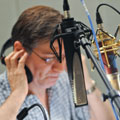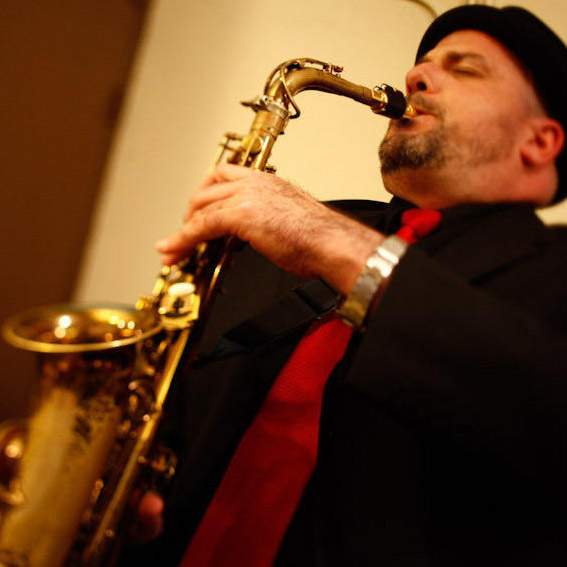
Six Ribbons, Two Voices
Saturday, August 2nd, 2014 | by matthew mcglynn
For this session of our “$1k Ribbon Mic Shootout“, we present two different male voices reading a narration. You’ll hear one voice through every mic at fixed distances (9 and in some cases also 4 inches), and a second voice at a distance selected for (subjectively) optimum results. Hear MP3s in a blind listening test below, or download the full-bandwidth audio session.
Studio & Session Setup
We used the exact same room and session setup as described in the previous two sessions. See details in the saxophone ribbon mic session notes.
We used a Stedman metal-mesh pop filter at all times.
The Voices
 The first voice you’ll hear belongs to Alex Q. Huffman, a San Francisco based musician and voice artist. Hear his demo reel on his Voice123 profile.
The first voice you’ll hear belongs to Alex Q. Huffman, a San Francisco based musician and voice artist. Hear his demo reel on his Voice123 profile.
Alex read a short excerpt from the Wikipedia page about ribbon microphones. We recorded this at two distances: 9 inches, which was arguably a bit too far for some of the mics, and 4 inches, which was without question way too too close for some of the mics.
I also recorded myself reciting the Zen and the Art of Mixing excerpt that I’ve been using for years to demo microphones. Rather than stand at the same distance from each mic, as we’d done with Alex, I used the “sweet spot” distance determined in the proximity test from an earlier session. This is what I referred to in the introduction: it is the distance that seemed to me to provide the best balance of frequencies for my own voice.
Text Transcript
Here is the script that Alex used:
The advantage of the ribbon microphone when it came out was that the light ribbon had a much higher natural resonant frequency than diaphragms in existing microphones, above hearing range, so it had flatter response at high frequencies. The voltage output of older ribbon microphones is typically quite low compared to a dynamic moving coil microphone and a step-up transformer is used to increase the voltage output.
Audio Files – Fixed Distances
We initially intended to present both the 9-inch and 4-inch tracks for every mic. But we realized that most of the 4-inch tracks were far too bass-heavy due to proximity effect, so rather than waste your time, we’ve omitted them. The MP3 players appearing below provide the 9-inch track for every mic, and the 4-inch track for selected microphones.
Ribbon Microphone #1
Ribbon Microphone #2
Ribbon Microphone #3
Ribbon Microphone #4
Ribbon Microphone #5
Ribbon Microphone #6
Ribbon Microphone #7
Ribbon Microphone #8
Ribbon Microphone #9
Ribbon Microphone #10
Ribbon Microphone #11
Listening Notes
The  AEA N22 at 9 inches is too thin and bright; it highlights mouth noise in exactly the way a voice microphone should not. Moving in to 4 inches, the mic’s frequency response is altered favorably — the bass fills in, and the treble rolls off. The N22 sounds much more balanced at this closer distance, with an interesting character to the upper mids, and a good amount of detail. That said, this mic still sounds too brightly voiced for Alex, in my opinion; there’s a whispery quality to the top end that I find distracting and non-organic.
AEA N22 at 9 inches is too thin and bright; it highlights mouth noise in exactly the way a voice microphone should not. Moving in to 4 inches, the mic’s frequency response is altered favorably — the bass fills in, and the treble rolls off. The N22 sounds much more balanced at this closer distance, with an interesting character to the upper mids, and a good amount of detail. That said, this mic still sounds too brightly voiced for Alex, in my opinion; there’s a whispery quality to the top end that I find distracting and non-organic.
The front and rear sides of the  Royer Labs R-101 at 9 inches sound more similar to each other than I would have expected, although the front side tends toward a sort of bandpassed character when compared to a brighter mic. The rear side sounds nicer, more open and lively, yet with a neutral (or perhaps attenuated) top end that actually serves Alex’ voice very well. Compare the R-101R (9 inches) to the N22 (4 inches); I think the R-101R wins, mostly due to the high frequencies being too present in the N22.
Royer Labs R-101 at 9 inches sound more similar to each other than I would have expected, although the front side tends toward a sort of bandpassed character when compared to a brighter mic. The rear side sounds nicer, more open and lively, yet with a neutral (or perhaps attenuated) top end that actually serves Alex’ voice very well. Compare the R-101R (9 inches) to the N22 (4 inches); I think the R-101R wins, mostly due to the high frequencies being too present in the N22.
The  AEA R92 front and rear sound nearly identical, at both working distances. The mic seems, in this case, to be very forgiving of placement, and somewhat immune to coloration change if the talent is moving around. I prefer the closer placement on Alex’ voice; the 9-inch tracks sound a bit too ambient, and the noise level is higher than I’d like to hear. The 4-inch tracks are superior in both respects. And they’re a bit more neutrally voiced, or less colored, than the R-101’s rear side, which has a midrangey vibe to it.
AEA R92 front and rear sound nearly identical, at both working distances. The mic seems, in this case, to be very forgiving of placement, and somewhat immune to coloration change if the talent is moving around. I prefer the closer placement on Alex’ voice; the 9-inch tracks sound a bit too ambient, and the noise level is higher than I’d like to hear. The 4-inch tracks are superior in both respects. And they’re a bit more neutrally voiced, or less colored, than the R-101’s rear side, which has a midrangey vibe to it.
The last three mics sound more similar to each other than to the first three mics we’ve heard. The Seville, Model 2, and AL39 have 2–5dB more output below 150Hz than the rest of these ribbons, and 2–5dB less output from 200Hz–3kHz. It gives them all a deep and authoritative sound that is very different from the first three ribbons.
The top end response of these three differs too, predictably: the Model 2 is brighter than the rest. The Seville is the darkest of the three.
I am drawn to this sound; all three of these mics make the other ribbons sound smaller, less exciting, and somewhat hyped in the mids. But I’m not sure any of these could be used without a high-pass filter. That is, they sound great through my reference headphones, but I do not expect that any of these tracks would be broadcast with all of those low frequencies intact.
By the way, during Alex’ session we recorded a U87 next to each ribbon. I have not mentioned it yet because the mic did not sound good to me; at 9 inches it seemed to be sharp, sibilant, hyped, and thin. To be fair, any condenser next to any ribbon is likely to sound thin… but the U87’s rolled-off lows and mildly boosted upper mids do not do any favors to Alex’ voice.
Audio Files – Optimized Distances
The following tracks present my own voice, recorded at the distance I felt was optimum for each microphone.
Ribbon Microphone #1
Ribbon Microphone #2
Ribbon Microphone #3
Ribbon Microphone #4
Ribbon Microphone #5
Ribbon Microphone #6
Ribbon Microphone #7
Ribbon Microphone #8
Optimized Distances
The use of ‘optimized’ working distances seems to have very effectively balanced the sound of these microphones. Characteristic colors remain, but these tracks don’t all make me want to immediately reach for EQ.
The  Cathedral Pipes Seville (10 inches) remains full and thick, giving it an engaging sense of authority. I hear a higher noise floor in this sample than I’d like. And the mic hears more ambient sound (room sound) than some of the 4–6 inch tracks, due to the larger working distance. But the mic can’t be dismissed for its tone; it sounds very good. If I owned this mic, I’d play with using a high pass filter to allow closer working distances; that would help reduce the noise level and the amount of ambient sound. Needless to say, using a proper vocal booth would help reduce the ambient sound too.
Cathedral Pipes Seville (10 inches) remains full and thick, giving it an engaging sense of authority. I hear a higher noise floor in this sample than I’d like. And the mic hears more ambient sound (room sound) than some of the 4–6 inch tracks, due to the larger working distance. But the mic can’t be dismissed for its tone; it sounds very good. If I owned this mic, I’d play with using a high pass filter to allow closer working distances; that would help reduce the noise level and the amount of ambient sound. Needless to say, using a proper vocal booth would help reduce the ambient sound too.
The rear side of the  AEA R92 (6 inches) sounds somewhat thin compared to most of the other microphones. It does not sound bad, but I like the front side more.
AEA R92 (6 inches) sounds somewhat thin compared to most of the other microphones. It does not sound bad, but I like the front side more.
The front side (recorded closer, at 4 inches) has rich but not overwhelming lows — due at least in part to the reduced working distance, of course. I like this sound a lot.
The  Mesanovic Model 2 (8 inches) track has boosted highs and lows, giving it a unique sound that is almost scooped in tone. It reminds me of my Beyerdynamic M99 (about which more in the Ultimate Podcasting Mic Shootout).
Mesanovic Model 2 (8 inches) track has boosted highs and lows, giving it a unique sound that is almost scooped in tone. It reminds me of my Beyerdynamic M99 (about which more in the Ultimate Podcasting Mic Shootout).
The Model 2 picks up more mouth noise than is ideal for me. If you have a trained voice, this wouldn’t likely be an issue.
The back side of the  Royer Labs R-101 (6 inches) sounds clean and clear. The mids come forward in a way that is unique among this set of microphones. I think this sounds great on my voice.
Royer Labs R-101 (6 inches) sounds clean and clear. The mids come forward in a way that is unique among this set of microphones. I think this sounds great on my voice.
I noticed that the R-101 and N22 were the lowest-noise mics in this set of samples. (This is in line with the findings of our noise analysis; see the ribbon mic lab tests.)
The  AEA N22 (4 inches) didn’t work as well at this distance as I’d hoped. My voice sounds flat and two-dimensional, and the mic caught too many plosives. I think both issues are a result of the very close working distance. I think this mic would have sounded better a bit further away.
AEA N22 (4 inches) didn’t work as well at this distance as I’d hoped. My voice sounds flat and two-dimensional, and the mic caught too many plosives. I think both issues are a result of the very close working distance. I think this mic would have sounded better a bit further away.
The  Samar Audio Design AL39 track has a nice balance, if perhaps a bit heavy in the bass, and a rich tone. The sound seems like a midpoint between the R-92 (front side) and the Model 2; the AL39 has a more lively and exciting sound than the R-92, and some (but not too much) of the Model 2’s processed/scooped vibe. But the AL39 captures less mouth noise than the Model 2.
Samar Audio Design AL39 track has a nice balance, if perhaps a bit heavy in the bass, and a rich tone. The sound seems like a midpoint between the R-92 (front side) and the Model 2; the AL39 has a more lively and exciting sound than the R-92, and some (but not too much) of the Model 2’s processed/scooped vibe. But the AL39 captures less mouth noise than the Model 2.
After writing these notes, I listened to all the tracks again, blind. In that test I picked the AL39 as my favorite on my own voice, and the R92 (front side) and Seville as a close second. I think they’ll all need EQ, but as raw audio tracks those are the ones I would want to start with.
By the way, you’ll hear pops (plosives) on many of these tracks. I tend not to criticize microphones for plosive performance, because they are in part a performance problem, and in part an engineering problem, and they can be fixed relatively easily via digital editing. In these samples, I left all plosives intact, but I don’t recommend making judgements about the mics based on this aspect of the tracks.
Session Download
Download the PT9 session file, which includes 24/48 audio files, here (111 MB, *.zip).
See previous session notes for the audio file naming conventions.
Related Sessions
If you’re interested in voiceover recording or ribbon microphones (or both), see these other session writeups, all of which include audio files:
Table of Contents
- Introduction to the new ribbon shootout
- Frequency Response and Proximity Test
- Six ~$1k Ribbon Mics on Alto Sax
- Female Vocals Ribbon Mic Shootout
- Voiceover
- Acoustic Guitar (coming soon)
- Drum Overheads (coming soon)
Posted in Microphones, Shootouts, voiceover | 7 Comments »














Andrew
August 4th, 2014 at 2:19 am
“…the light ribbon had a much higher natural resonant frequency than diaphragms in existing microphones, above hearing range…”
Major fail for Wiki. The resonant frequency of ribbon mics is at the low end of the spectrum, maybe about 20Hz or so.
Good comprehensive set of comparisons though.
Josh Woodward
August 29th, 2014 at 12:42 pm
Looks like I have some shopping to do. On both tests, blind, my #1 and 2 were the rear R92 and the front R92.
Trevor Masterson
September 15th, 2014 at 9:11 am
Listening through Lavry DA-10 > Mackie HR824s in a well treated room.
I’m in between 5 and 6. 5 is probably the most natural and 6 is slightly clearer, but maybe a bit hyped in the top end. These 2 were clear winners for me; loads more detail than the others. Good work Samar and Mesanovic!
2 and 8 are also quite good.
3 & 7 stand out as being the worst for this application. Wow, I’ve just ruled both the Royers out for vocals.
Trevor Masterson
September 15th, 2014 at 10:09 am
Just realised, there’s two tests here. The above comments were based on listening toTest 2.
For test 1, I liked pretty much the same Mics. Samar was my favourite – the most natural and balanced across the whole frequency spectrum, followed by Mesanovic (a touched scooped in this application) and Cathedral Pipes, which was also a bit bass heavy.
I also picked out 10, 6 and 8 next, which are all from the R92.
Matt Baker
January 16th, 2015 at 11:38 am
Ready to hear the drum overheads shootout!!
George Papachoris
November 30th, 2015 at 12:27 am
Matthew McGlynn:
Your work on 6 mics tape is unbelievably good … Congratulations !!
Samar AL39 you selected as your favorite for voice, and I totally agree.
But: It does not exist. Instead Samar is offering the VL37 and VL37A (Active); You’ve heard the equal sircunstancias? …
I want to buy the AL39, no. The VL37 equals … ???
I appreciate your professional support and advice.
George Papachoris
Culiacan, Sinaloa. Mex.
matthew mcglynn
November 30th, 2015 at 12:33 am
@George, I believe Samar discontinued the AL39, even before I had completed my review. You can contact Samar directly. Perhaps they will make more of the AL39.